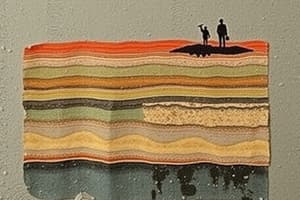Podcast
Questions and Answers
What is the most abundant element in the Earth's crust?
What is the most abundant element in the Earth's crust?
- Silicon
- Aluminum
- Oxygen (correct)
- Iron
What is the main reason the materials in the inner core remain solid?
What is the main reason the materials in the inner core remain solid?
- High pressure (correct)
- Low temperature
- Chemical composition
- Magma presence
Which of the following discontinuities marks the boundary between the outer core and the inner core?
Which of the following discontinuities marks the boundary between the outer core and the inner core?
- Mohorovicic Discontinuity
- Lehmann Discontinuity (correct)
- Conrad Discontinuity
- Gutenberg Discontinuity
Which seismic waves are absorbed by the outer core?
Which seismic waves are absorbed by the outer core?
What marks the interface between the Earth's crust and mantle?
What marks the interface between the Earth's crust and mantle?
What phenomenon explains the existence of a shadow zone in seismic wave detection?
What phenomenon explains the existence of a shadow zone in seismic wave detection?
Which layer of the Earth is located directly below the crust?
Which layer of the Earth is located directly below the crust?
What scientific method is primarily used to study the Earth's internal structure?
What scientific method is primarily used to study the Earth's internal structure?
Flashcards are hidden until you start studying
Study Notes
Earth's Composition and Structure
- Oxygen is the most abundant element in the Earth's crust.
- The inner core is primarily composed of iron and nickel.
- High pressure keeps the solid state of materials in the inner core despite extreme temperatures.
Mechanical and Chemical Layers
- Mechanical layers include the lithosphere, asthenosphere, mesosphere, outer core, and inner core.
- Chemical layers consist of the crust, mantle, outer core, and inner core.
Earth Layer Boundaries
- Discontinuities indicate boundaries between Earth's layers:
- Conrad Discontinuity: separates the upper and lower crust.
- Mohorovicic Discontinuity (Moho): boundary between the crust and mantle.
- Gutenberg Discontinuity: boundary between the mantle and outer core.
- Lehmann Discontinuity: boundary between the outer and inner core.
Seismic Waves and Earth's Layers
- Seismic wave behavior provides insight into Earth's internal structure:
- Primary waves (P-waves) can travel through solid and liquid, but are refracted at core boundaries.
- Secondary waves (S-waves) only travel through solids and are absorbed in the outer core.
- Time measurements of seismic waves help determine the solid, liquid, and gas states of Earth's layers.
Density and Velocity of Seismic Waves
- In 1909, Andrija Mohorovicic discovered changes in seismic wave velocity, indicating layered density differences within the Earth.
- The presence of a shadow zone for P-waves suggests a core composed of different material than the mantle, confirming the existence of the outer core as a liquid layer.
Studying That Suits You
Use AI to generate personalized quizzes and flashcards to suit your learning preferences.




